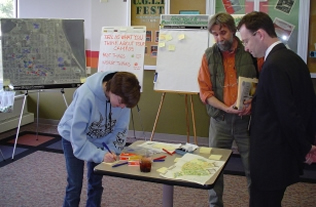
Green Fingers. Consolidation. Dual Campuses. A consulting firm has assigned these working titles to three “broad development scenarios” for changes to Northern’s physical campus. JJR from Ann Arbor was contracted in February to help the university update its master plan, which typically spans 15-20 years. The firm began by obtaining feedback from employees and students (an April open house and issue brainstorming session held at the LRC is pictured).
JJR’s initial goal was to analyze the campus layout, use of facilities, space allocation, vehicle and pedestrian traffic patterns and links between different areas of campus. The firm also identified the core of campus with the goal of establishing a five-minute walk radius to academic and service locations.
“In a couple of months, JJR will visit campus and present a consolidated plan to the president’s council and two working committees,” said Jim Thams (Engineering and Planning) at the July 17 forum. “We will make those scenarios available to the campus community via the Web so they can review them. We will also present them to the campus community at forums and explain the reasoning behind them. The goal is to work through the fall semester on refining the plan and complete it by the end of the semester.”
Doug Kozma from JJR presented the three plans to the president’s council last month. All three call for consolidation around an academic cluster and the need for student union space within the cluster. The Green Fingers plan emphasizes the creation of more meaningful open spaces. “We would improve the streetscape and remove vehicles and parking from inside the core campus," Kozma said. "This is valuable real estate. The key must be to designate permanent green space so it won’t get eaten away over time as the campus grows.”
Key points of the plan include a student union addition to the Learning Resources Center; facilitating a mix of small, student-focused businesses on Presque Isle Ave.; making Presque Isle a boulevard so students only have to cross halfway at a time; working with the city on a technology park to encourage more collaboration with students and faculty; physically connecting the university to Marquette General Hospital; giving the sports complex a significant gateway to distinguish it from the rest of campus; and building green bridges with service streets running beneath them.
The Consolidation plan brings more focus to the center of campus and includes a pedestrian link to Lake Superior. The plan would improve perimeter circulation with traffic flow parallel to the academic mall rather than through it, in part by realigning Kaye Street. The residence facilities on Lincoln and Center Streets would be removed in favor of housing on the main campus.
Kozma said the Dual Campus plan “takes what’s already happening to a certain degree and makes more of it. It creates two distinct cores and emphasizes the idea of a five-minute walk for most things a student needs to do. Northern would have to cluster the types of programs that have similar needs so most students wouldn’t have to run from one sub-campus to the other.”
Hedgcock would serve as the divider between the two academic clusters and also the site of a student union. East campus would revolve around the University Center. West campus would be focused on the Learning Resources Center. Other highlights include creating a large recreation area on the interior of the east sector; removing Seventh Street; and relocating family housing in the vicinity of Quad 1. |


 Master Plan Scenarios Presented
Master Plan Scenarios Presented 
